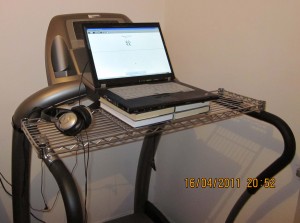In an interview about his new book The JFK Assassination Diary, Edward Jay Epstein was asked how he, a Cornell undergraduate, managed to talk to the people who did the research behind the Warren Commission Report. “It was a different age,” he said. “People actually communicated by sitting across a desk from one another and talking.” When I heard this, I was amused. I had just discovered that it was much better to meet with students walking than seated. What Epstein considered the good old-fashioned way (seated meetings) was to me the crazy new-fangled way.
As I’ve blogged, this semester I am teaching a class about academic writing. I am trying to apply my no grading/no lecturing method that worked well last year in a much different class (Frontiers of Psychology). In the writing class, my plan was/is to meet with students one-on-one right after class, in the same room. They choose the meeting length. During the meeting they show me what they’ve written and I make comments. During the next class they give a brief talk (e.g., 10 minutes) in which they tell the rest of the students what I told them. The course is much easier to teach than usual: no lecture, no grading, no written comments. Yet the students get as much one-on-one feedback as they want. I think spoken (face to face) comments are much better than written ones because they allow the recipient to ask questions.
Right now we covering how to write a personal statement for graduate school applications. The first set of after-class meetings was a week ago. The class has 12 students. Five signed up for meetings, 10-15 minutes each, an hour total. At the end of the hour I was tired. It was hard to concentrate that long. I went home and rested.
The class meets once/week. I thought of my discovery it was much easier to study Chinese while walking than while sitting (more here). While sitting I got exhausted after 10 minutes. While walking (on a treadmill), I could easily study 40 minutes. Jeremy Howard discovered the same thing. He put it like this:
[On a treadmill] I can [study Chinese] for an hour. Normally if I’m just sitting down I can just do it 20 minutes. . . . And at the end of that hour I was ready to do something else. Whereas at the end of 20 minutes, normally I’d be totally ready for a rest.
This gave me the idea of meeting with my students while walking. I’ve done walking interviews many times — for example, with job candidates and fellowship applicants. I didn’t like sitting for long periods of time and I hoped that walking would reduce their anxiety. It seemed to work.
During the next class, I announced the change: Bring a printed copy of your work (while walking I could not read a computer screen). I said they didn’t need a printed copy today, just in the future. After that class, I had four meetings. In three cases, the student did not have a printed copy so I started with the one student who did. I was pleasantly surprised that the other three students had made printed copies of their work by the time of their meeting so I did all four meetings walking.
What a difference! The meetings felt like no work at all. At the end of them, I felt refreshed. Yet their details (who, when, what, how long, etc.) were very close to what had left me tired a week earlier.
Maybe in the future offices and meeting rooms will have side by side treadmills and you project what you want to look at together on the wall. Another advocate of walking meetings is Nilofer Merchant. She says she listens better, mobile phones are less distracting, and the mood is better.
Humans evolved to specialize and trade. Specialized knowledge needed to be passed down, so we must, under the right circumstances, enjoy teaching, just as a healthy diet must taste good.
